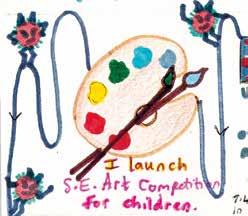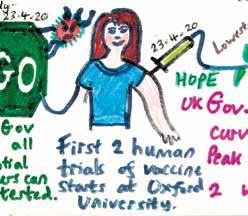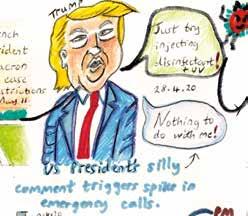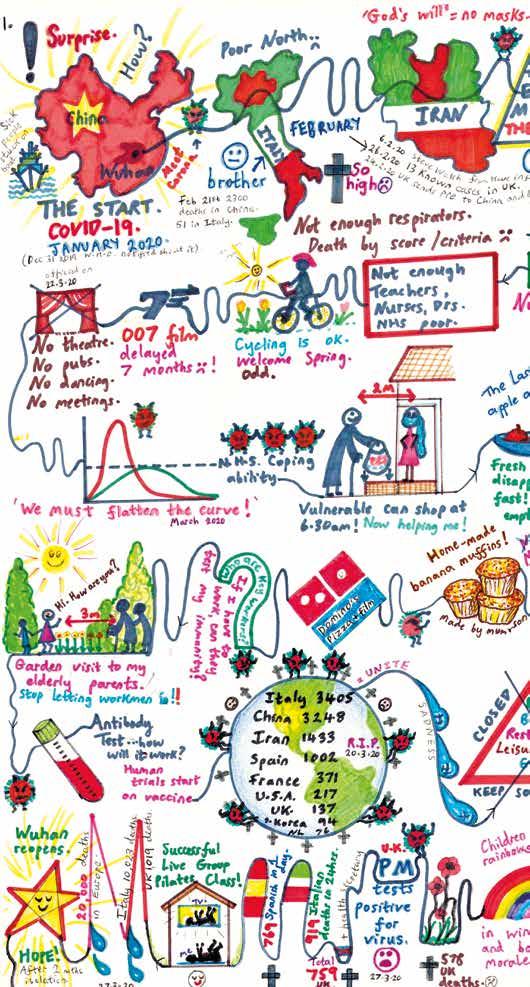
4 minute read
Art and anxiety
Art in a pandemic: capturing the Covid crisis
Sarah Thompson discovers how creating a visual timeline of world events helped a teacher manage her anxiety during this extraordinary time.
IN mid-March 2020, art and design teacher Nicky Gallagher found herself unable to sleep. She was feeling increasingly unsettled by coronavirus developments and was self-isolating because her daughter had a temperature.
“I had anxiety,” she says. “I was watching the news too much and I was stuck at home.”
At 2.30 am, Nicky began to research the events of the pandemic since January – dates, facts and statistics – and record them on a visual timeline, something known as story mapping.
“It was essentially a mindfulness activity to calm myself down,” she says. Three hours later, she’d drawn three lines of illustrations and posted a video on YouTube to explain her project, in the hope it might help other people.
The technique of story mapping is one that Nicky uses regularly at Warren Road, a Talk for Writing primary school in Orpington, south east London, where she works as a year 1 teacher and subject lead. “It’s second nature to me that to tell a story, you visually map it first,” she says. “That’s how we teach.” continued on page 28
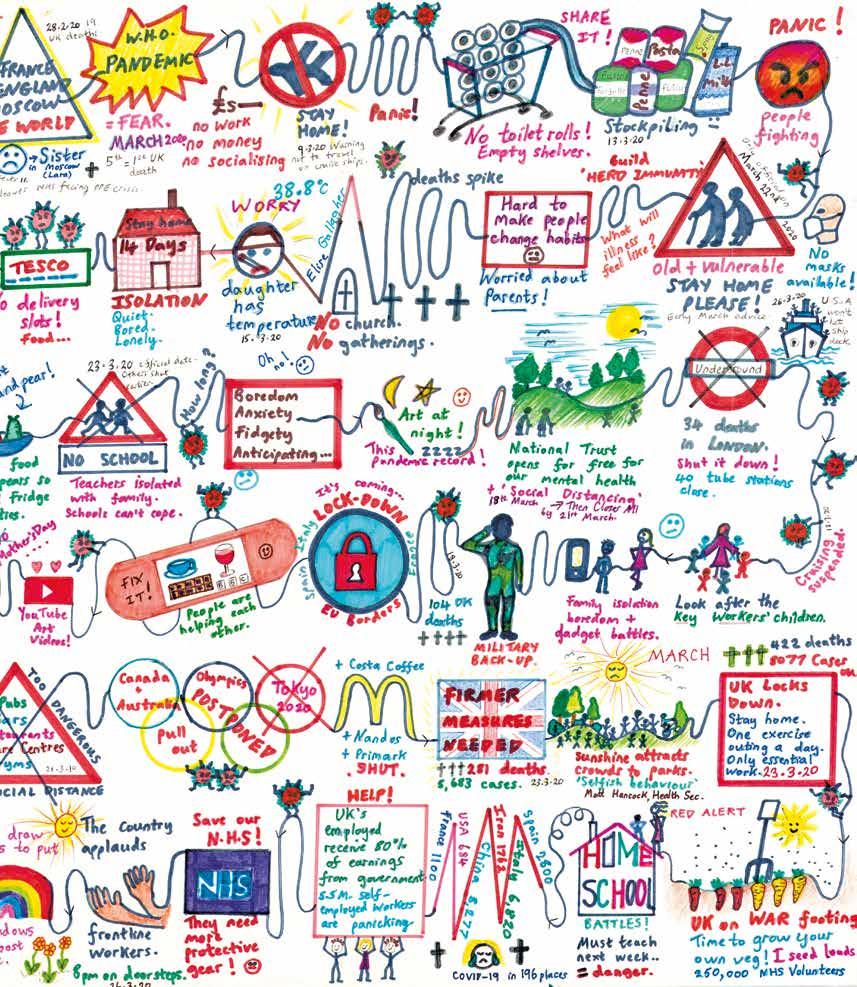
continued from page 27
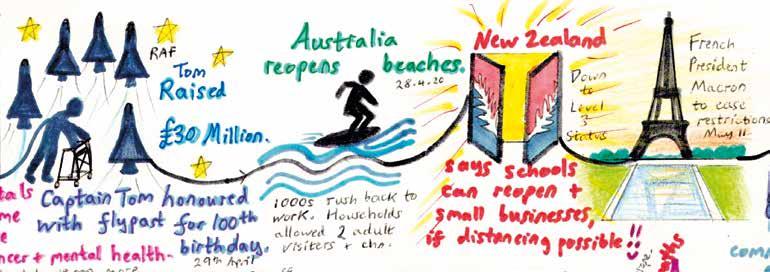
Nicky Gallagher (left)
Nicky’s timeline is now more than 10 metres long and covers 17 sheets of A2 paper. The first ten sheets have been donated to the Museum of London’s project, Collecting Covid (museumoflondon.org.uk). The collection will include objects and first-hand accounts to illustrate how the pandemic affected the lives of Londoners. The museum has collections relating to other London epidemics, including smallpox and the 18891893 and 1918 flu pandemics.
It will be held at the museum for perpetuity. “Isn’t that quite funny?” Nicky says. “There’ll be things in the museum’s archives made of gold, from ancient times that are super valuable, and then sitting next to them are my little Sharpie drawings of stick people in masks, Covid monsters with flexed muscles, and my parents coming over for tea and Battenburg cake. I’ll be really interested to see – when the exhibition opens – what other art the museum has chosen.”
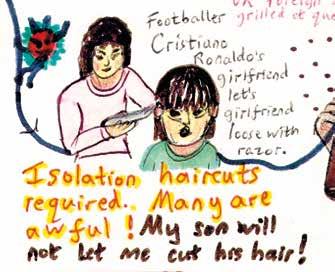
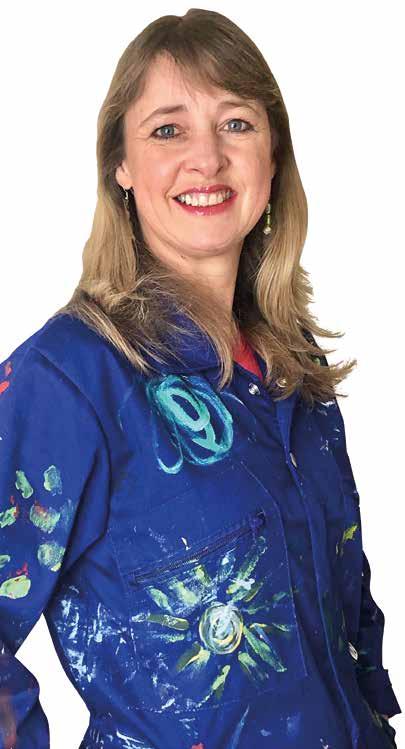
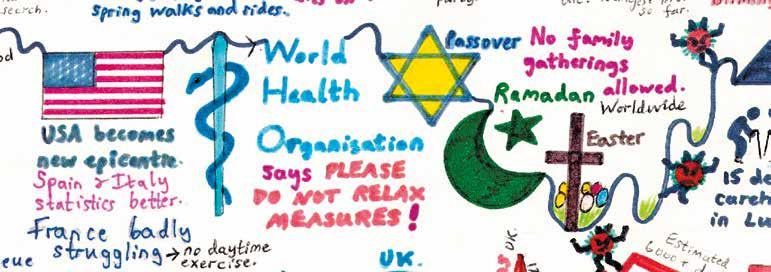
Grocery stockpiles, gadget squabbles
As well as a record of the news events around Covid, the timeline is a personal account of Nicky’s experience of the pandemic from “the perspective of a London mum”.
It is a record of her anxieties and frustrations – the lack of NHS funding, stockpiling of groceries, feelings of isolation and ‘gadget battles’ with her children – but also those things which helped her. These included riding her bike, virtual Pilates classes and what she calls her “fix it!” plaster, “the BBC, homemade muffins, red wine and chocolate – which summed up my life then”.
The timeline is an ambitious work, referencing international events too. Nicky has family in Moscow, Italy and South Africa, and she wanted to record what was happening in those and other countries. The postponement of the Tokyo Olympics, the reopening of Wuhan in China, and Donald Trump’s suggestion that injecting bleach could cure Covid all appear.
Nicky says she wanted to place the pandemic in a historical context, so has also included other non-Covid events, for example the successful flight of NASA’s Ingenuity Mars helicopter.
One of the consequences of the pandemic, Nicky hopes, is that art – often the first thing to go from school timetables – has a new value, going hand-in-hand with wellbeing.
“Art has increased in priority,” she says. “Wellbeing is top of everybody’s list in school and art goes with it. It’s good for the children.”
And for Nicky, art remains very much the priority. The week we spoke she said she had 12 hours of art to catch up on.
“I’m like an ancient Egyptian scribe,” she laughs. “It’s my job to carry on.”
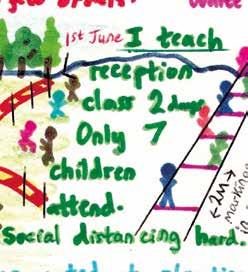
Talk for Writing
Talk for Writing, developed by Pie Corbett, uses story mapping as a way of helping children learn the elements of a book or story. By recording the plot, characters and setting along a line using illustrations, children can ‘see’ the story, enabling them to become familiar with it and use it as a basis to create their own work. Visit talk4writing.com Art with Mrs G
Nicky’s online tutorials include anything from Picasso-style portraits and drawing villains, to printing with fruit and vegetables. Aimed primarily at primary age children, they have also been popular with her colleagues and children’s parents. Visit bit.ly/34bimp7
